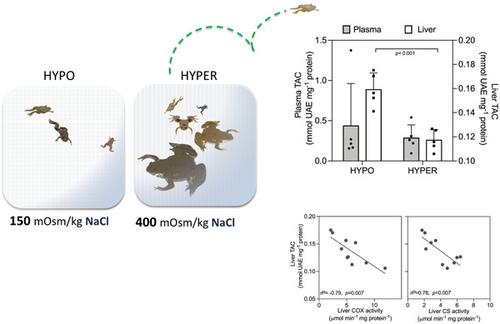当前位置:
X-MOL 学术
›
J. Exp. Zool. Part A
›
论文详情
Our official English website, www.x-mol.net, welcomes your feedback! (Note: you will need to create a separate account there.)
Effect of salinity acclimation on osmoregulation, oxidative stress, and metabolic enzymes in the invasive Xenopus laevis.
Journal of Experimental Zoology Part A ( IF 2.8 ) Pub Date : 2020-04-19 , DOI: 10.1002/jez.2360 Jaime Hidalgo 1 , Felipe Álvarez-Vergara 1 , Isaac Peña-Villalobos 1, 2 , Carolina Contreras-Ramos 1 , Juan C Sanchez-Hernandez 3 , Pablo Sabat 1, 4
Journal of Experimental Zoology Part A ( IF 2.8 ) Pub Date : 2020-04-19 , DOI: 10.1002/jez.2360 Jaime Hidalgo 1 , Felipe Álvarez-Vergara 1 , Isaac Peña-Villalobos 1, 2 , Carolina Contreras-Ramos 1 , Juan C Sanchez-Hernandez 3 , Pablo Sabat 1, 4
Affiliation

|
Aquatic animals often display physiological adjustments to improve their biological performance and hydrosaline balance in saline environments. In addition to energetic costs associated with osmoregulation, oxidative stress, and the activation of the antioxidant system are common cellular responses to salt stress in many species, but the knowledge of osmoregulation‐linked oxidative homeostasis in amphibians is scarce. Here we studied the biochemical responses and oxidative responses of Xenopus laevis females exposed for 40 days to two contrasting salinities: hypo‐osmotic (150 mOsm·kg−1·H2O NaCl, HYPO group) and hyper‐osmotic environments (340 mOsm·kg−1·H2O NaCl, HYPER group). We found an increase of plasma osmolality and plasma urea concentration in the animals incubated in the HYPER treatment. Increases in electrolyte concentration were paralleled with an increase of both citrate synthase and cytochrome c oxidase activities in liver and heart. Interestingly, HYPO group had higher catabolic activity of the skin and liver total antioxidant capacity (TAC), compared with animals from the HYPER group. Moreover, there was an inverse relationship between liver TAC and plasma osmolality; and with the metabolic enzymes from liver. These findings suggest that salinity induces changes in urea metabolism and specific activity of metabolic enzymes, which appears to be tissue‐dependent in X. laevis. Contrary to our expectations, we also found a moderate change in the oxidative status as revealed by the increase in TAC activity in the animals acclimated to low salinity medium, but constancy in the lipid peroxidation of membranes.
中文翻译:

盐度适应对入侵非洲爪蟾的渗透调节,氧化应激和代谢酶的影响。
水生动物通常会表现出生理适应性,以改善其在盐环境中的生物学性能和生理盐水平衡。除了与渗透调节相关的能量消耗外,氧化应激和抗氧化系统的激活是许多物种对盐胁迫的常见细胞反应,但是两栖动物中渗透调节相关的氧化稳态的知识却很少。在这里,我们研究了在两种相反的盐度下暴露40天的非洲爪蟾女性的生化反应和氧化反应:低渗(150 mOsm·kg -1 ·H 2 O NaCl,HYPO组)和高渗环境(340 mOsm·千克-1 ·H 2NaCl,HYPER组)。我们发现在HYPER处理中孵育的动物血浆渗透压和血浆尿素浓度增加。电解质浓度的增加与肝脏和心脏中柠檬酸合酶和细胞色素c氧化酶活性的增加同时发生。有趣的是,与HYPER组的动物相比,HYPO组的皮肤和肝脏的总抗氧化能力更高,总抗氧化能力(TAC)。此外,肝脏TAC与血浆渗透压之间存在反比关系。以及来自肝脏的代谢酶。这些发现表明盐度会引起尿素代谢和代谢酶比活性的变化,这似乎与X. laevis呈组织依赖性。。与我们的预期相反,我们还发现,在适应低盐度培养基的动物中TAC活性的增加表明了氧化状态的适度变化,但膜的脂质过氧化作用却是恒定的。
更新日期:2020-04-19
中文翻译:

盐度适应对入侵非洲爪蟾的渗透调节,氧化应激和代谢酶的影响。
水生动物通常会表现出生理适应性,以改善其在盐环境中的生物学性能和生理盐水平衡。除了与渗透调节相关的能量消耗外,氧化应激和抗氧化系统的激活是许多物种对盐胁迫的常见细胞反应,但是两栖动物中渗透调节相关的氧化稳态的知识却很少。在这里,我们研究了在两种相反的盐度下暴露40天的非洲爪蟾女性的生化反应和氧化反应:低渗(150 mOsm·kg -1 ·H 2 O NaCl,HYPO组)和高渗环境(340 mOsm·千克-1 ·H 2NaCl,HYPER组)。我们发现在HYPER处理中孵育的动物血浆渗透压和血浆尿素浓度增加。电解质浓度的增加与肝脏和心脏中柠檬酸合酶和细胞色素c氧化酶活性的增加同时发生。有趣的是,与HYPER组的动物相比,HYPO组的皮肤和肝脏的总抗氧化能力更高,总抗氧化能力(TAC)。此外,肝脏TAC与血浆渗透压之间存在反比关系。以及来自肝脏的代谢酶。这些发现表明盐度会引起尿素代谢和代谢酶比活性的变化,这似乎与X. laevis呈组织依赖性。。与我们的预期相反,我们还发现,在适应低盐度培养基的动物中TAC活性的增加表明了氧化状态的适度变化,但膜的脂质过氧化作用却是恒定的。



























 京公网安备 11010802027423号
京公网安备 11010802027423号